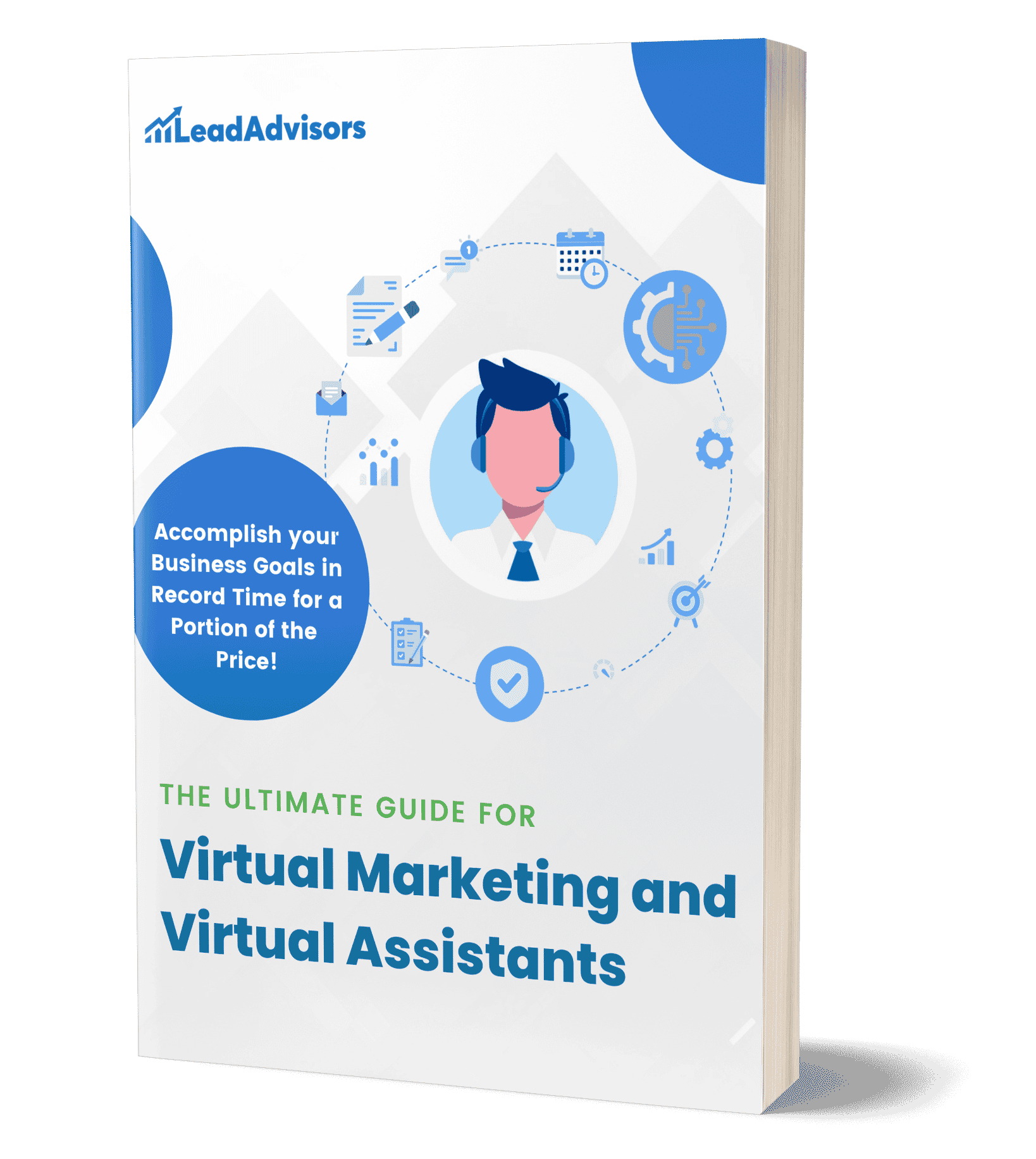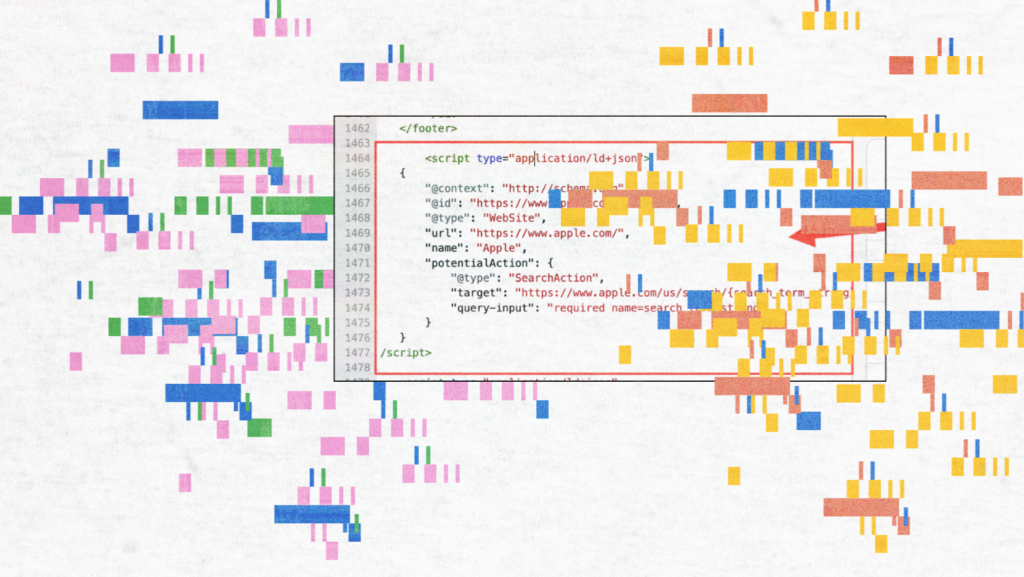If you’re in cybersecurity, you’ve probably wondered whether SEO is worth the investment. The short answer? It’s not just worth it – it’s essential.. Even with the most secure systems, your impact is limited if clients can’t find you online.
Over 51% of website traffic comes from organic search, so if you’re not showing up in search results, you’re missing out on customers who desperately need your protection. Higher search engine rankings don’t just drive clicks; they shape how people perceive your brand. In a world full of cyberthreats, visibility builds credibility.
That trust starts with a focused search engine optimization strategy tailored to the cybersecurity industry.
What Is Cybersecurity SEO?
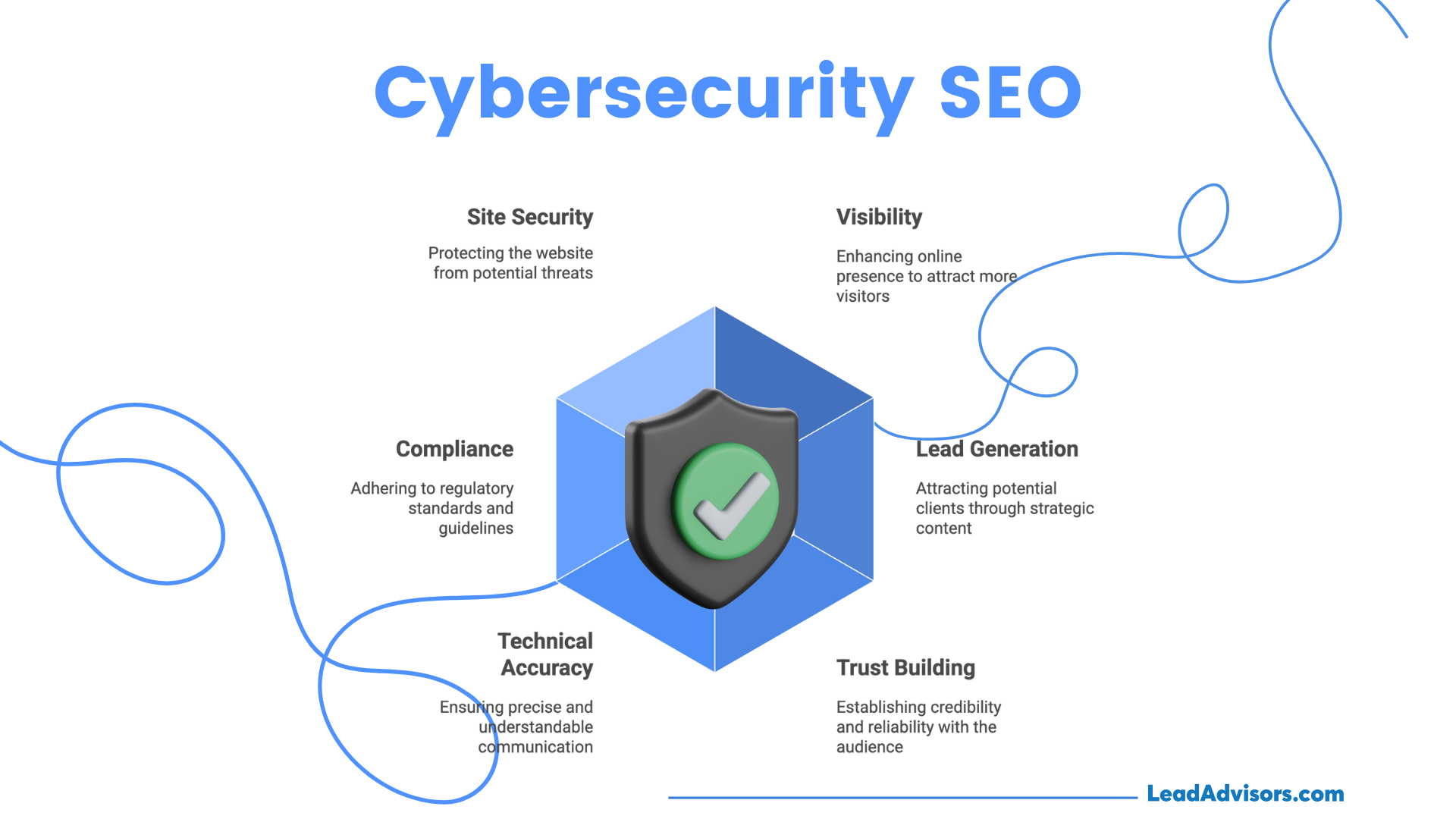
Cybersecurity SEO is the process of optimizing your website to rank higher on search engines. But here’s the thing – it’s not just about chasing rankings. You’re really after three things: getting found, generating leads, and building trust.
“Unlike other industries, cybersecurity SEO comes with some unique challenges. You’re not just fighting for clicks – you’re fighting to prove you can be trusted with people’s most sensitive data. Key hurdles include:
- Using accurate yet simple language for technical terms
- Addressing strict compliance and regulations
- Protecting against risks if your own site isn’t secure
That’s why cybersecurity SEO demands thoughtful strategies that rank, resonate, and prove your expertise.
The Synergy Between SEO and Cybersecurity
Here’s something interesting: SEO and cybersecurity actually depend on each other.
When cybersecurity fails, SEO suffers.
Hacked or slow-loading sites get flagged by search engines, often marked unsafe, causing rankings to drop. Even small lapses like missing SSL certificates or lacking HTTPS can cost you organic traffic.
When SEO is weak, credibility suffers.
If people search your business but find no secure, professional site, you lose both traffic and trust. In cybersecurity, reputation is everything.
Together, strong SEO and security deliver:
- Higher search rankings
- Stronger online visibility
- Greater customer confidence
Without both working together, you could end up blacklisted by Google, miss out on great opportunities, and damage your reputation for years.
Core Cybersecurity SEO Strategies
A. Keyword Research & Content Strategy
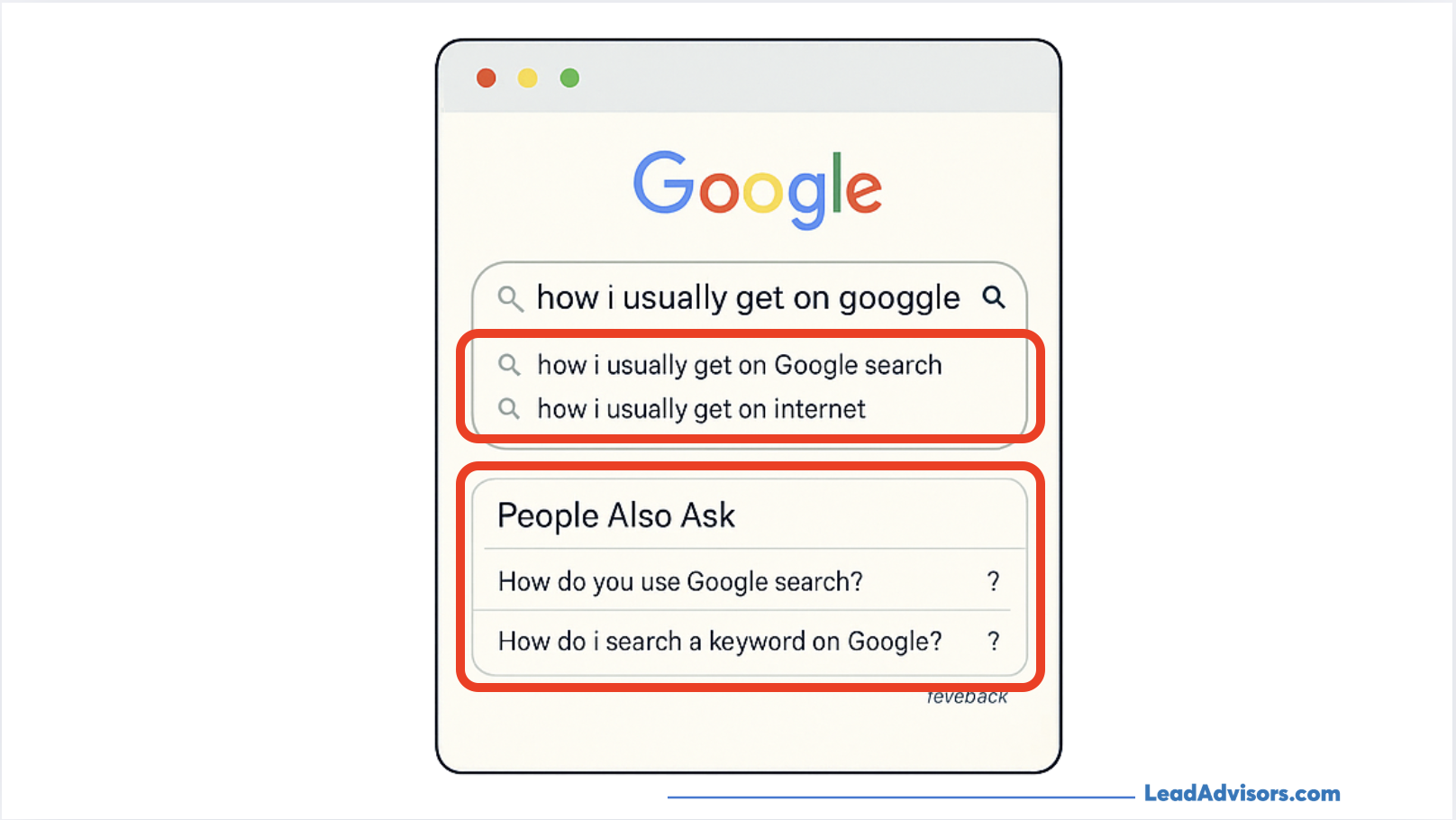
Good cybersecurity SEO starts with understanding what your audience actually searches for – and why they’re searching for it. Without this insight, you’re basically throwing darts in the dark.
Start with some simple Google research:
- Autosuggest – real queries in real time
- People Also Ask – related questions and search intent.
Once you’ve got the basics down, tools like Ahrefs or Semrush can help you find:
- Keyword gaps from competitors
- Long-tail terms (e.g., “cybersecurity audit for small business”)
- Service-related brand combinations
Next, tailor content to your audience:
- CISOs & IT leaders want technical depth
- Business executives care about outcomes and risk.
Aim for content that balances both. Finally, map relevant keywords to the buyer’s journey:
| Funnel Stage | Search Intent Example |
| Top | “What is ransomware?” |
| Mid | “cybersecurity solutions for SMBs” |
| Bottom | “penetration testing company near me” |
When you match your content to where people are in their buying journey, you’ll not only show up in searches – you’ll actually connect with the right people.
B. High-Quality, Expert-Led Content
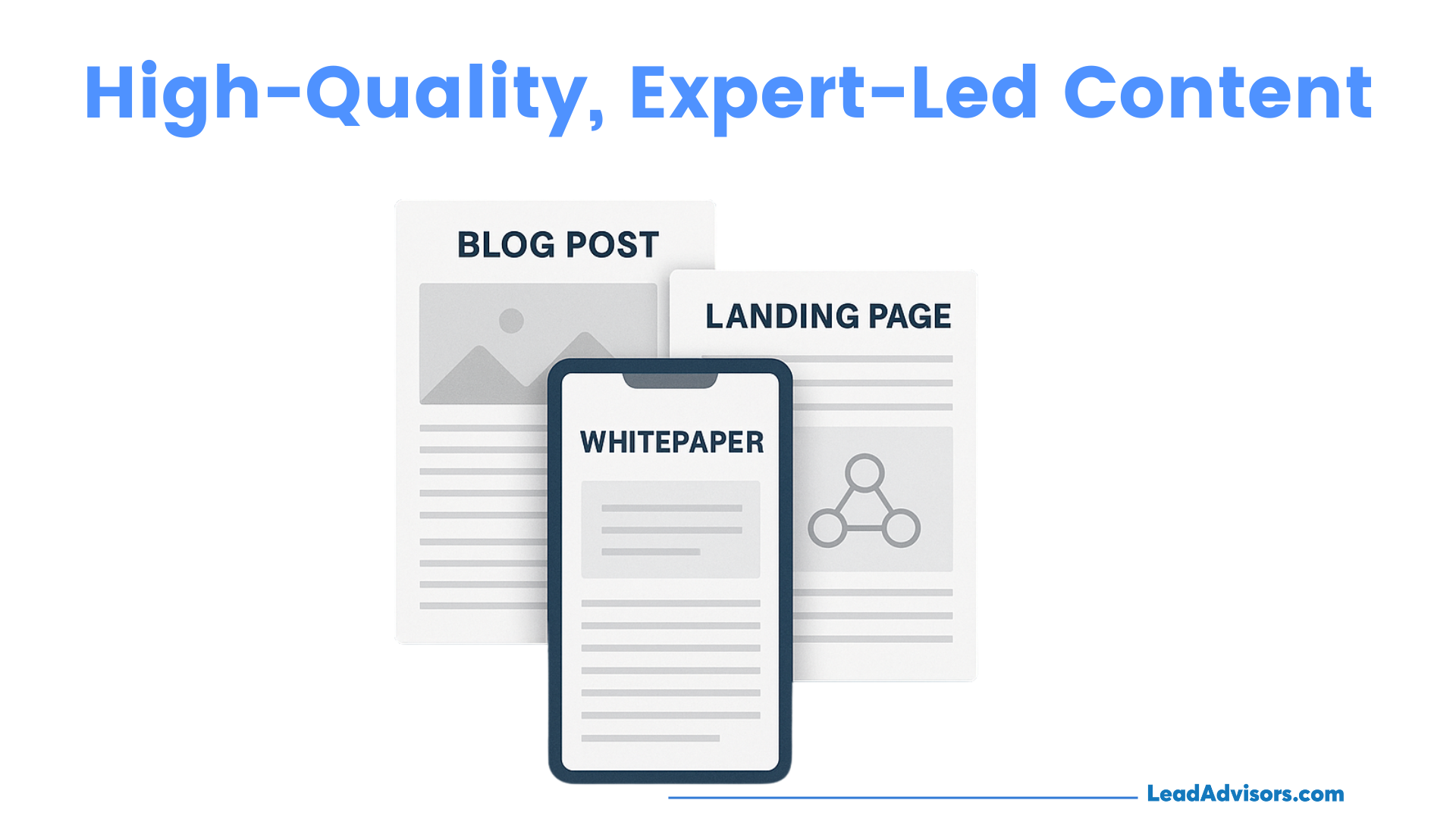
Once you know what keywords to target, it’s time to create content that actually establishes your authority. Blog posts should simplify complex threats, landing pages should clearly explain services, and whitepapers should showcase expertise.
Key points:
- Leverage EEAT (Experience, Expertise, Authoritativeness, Trustworthiness) with bios, citations, and credible sources
- Lead with your most important information – don’t bury the good stuff at the bottom.
- Prioritize clarity over complexity – even technical readers prefer concise, skimmable content.
Strong, authoritative content improves rankings, builds trust, encourages repeat visits, and converts readers into clients.
Technical SEO for Cybersecurity Sites
Technical SEO may not be flashy, but it’s critical for cybersecurity companies. If your site isn’t secure, fast, and easy to navigate, both users and search engines will leave, costing you rankings and leads.
A. Website Security & SEO
Trust begins with security. A “Not Secure” browser warning immediately undermines credibility, and Google uses HTTPS as a ranking signal. SSL certificates not only protect users but also impact SEO.
Additional essentials include:
- Web Application Firewalls (WAFs)
- Malware and vulnerability scans
- Bot filtering and protection
- Encrypted cookies and secure forms
- Content Security Policy (CSP) against injection attacks
For CMS platforms like WordPress, regular backups and plugin audits are vital. Strong security safeguards protect users, maintain rankings, and prevent blacklisting.
B. Site Performance
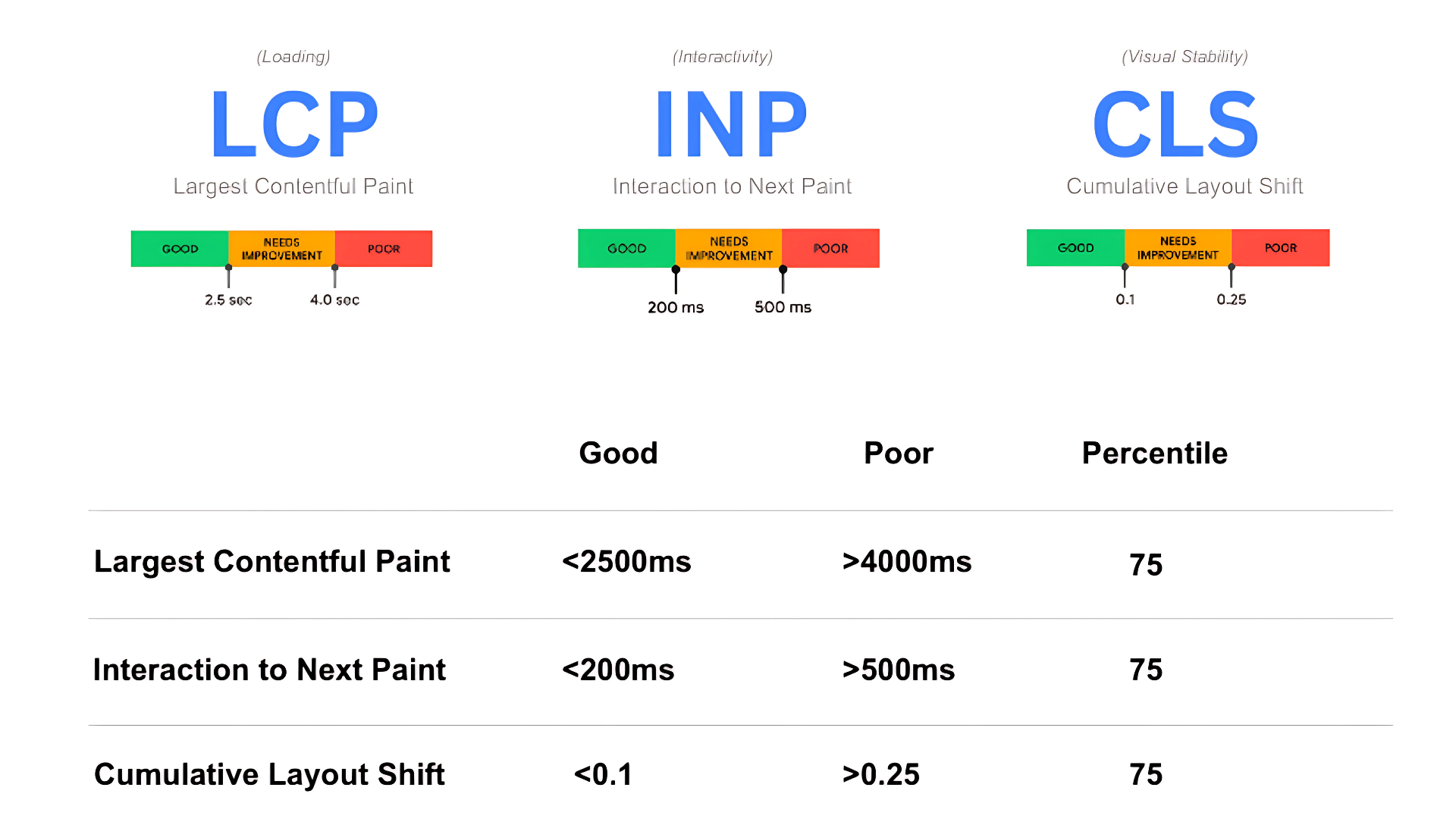
Speed and usability are major ranking factors, especially on mobile. Google’s Core Web Vitals measure:
- Largest Contentful Paint (LCP) – loading speed
- First Input Delay (FID) – interactivity
- Cumulative Layout Shift (CLS) – visual stability
Optimize with mobile-first design, clean code, compressed images, lazy loading, and accessibility basics like alt text and semantic HTML. These improvements enhance user experience and search visibility.
C. Crawlability & Indexation
Content only helps if search engines can find and interpret it. Key steps:
- Maintain an updated XML sitemap and robots.txt
- Use schema markup to clarify the content’s purpose.
- Keep URLs structured and straightforward.
- Resolve duplicates with canonical tags.
These practices ensure your site is crawlable, indexable, and fully optimized to support strong cybersecurity SEO.
Local SEO for Regional Cybersecurity Firms
The Problem: You run a strong cybersecurity business, but when someone nearby searches “cybersecurity firm near me,” you’re invisible.
The Solution: Local SEO – a targeted strategy to improve visibility in your geographic area so nearby customers can find and trust you.
Problem #1: No Google Business Profile
Fix: Claim and optimize it with services, categories, hours, contacts, and images. This improves rankings and gets you into the local pack.
Problem #2: Inconsistent Business Info
Fix: Keep your NAP (name, address, phone) consistent across your site, Clutch, Yelp, G2, and directories. Consistency boosts trust with search engines.
Problem #3: No Location Targeting on Website
Fix: Create local landing pages with city-specific keywords, services, and FAQs to rank in regional searches.
Problem #4: No Local Content
Fix: Write about regional compliance laws, industry risks, or community events. This improves relevance and draws local organic traffic.
Problem #5: Few or No Reviews
Fix: Ask satisfied clients for reviews on Google, G2, or Clutch. Reviews build credibility and directly improve local rankings. Combine this with local link-building strategies to strengthen your presence in local search results.
When these gaps are fixed, your cybersecurity firm will not only appear in local results but also stand out.
Link-Building & Digital Authority
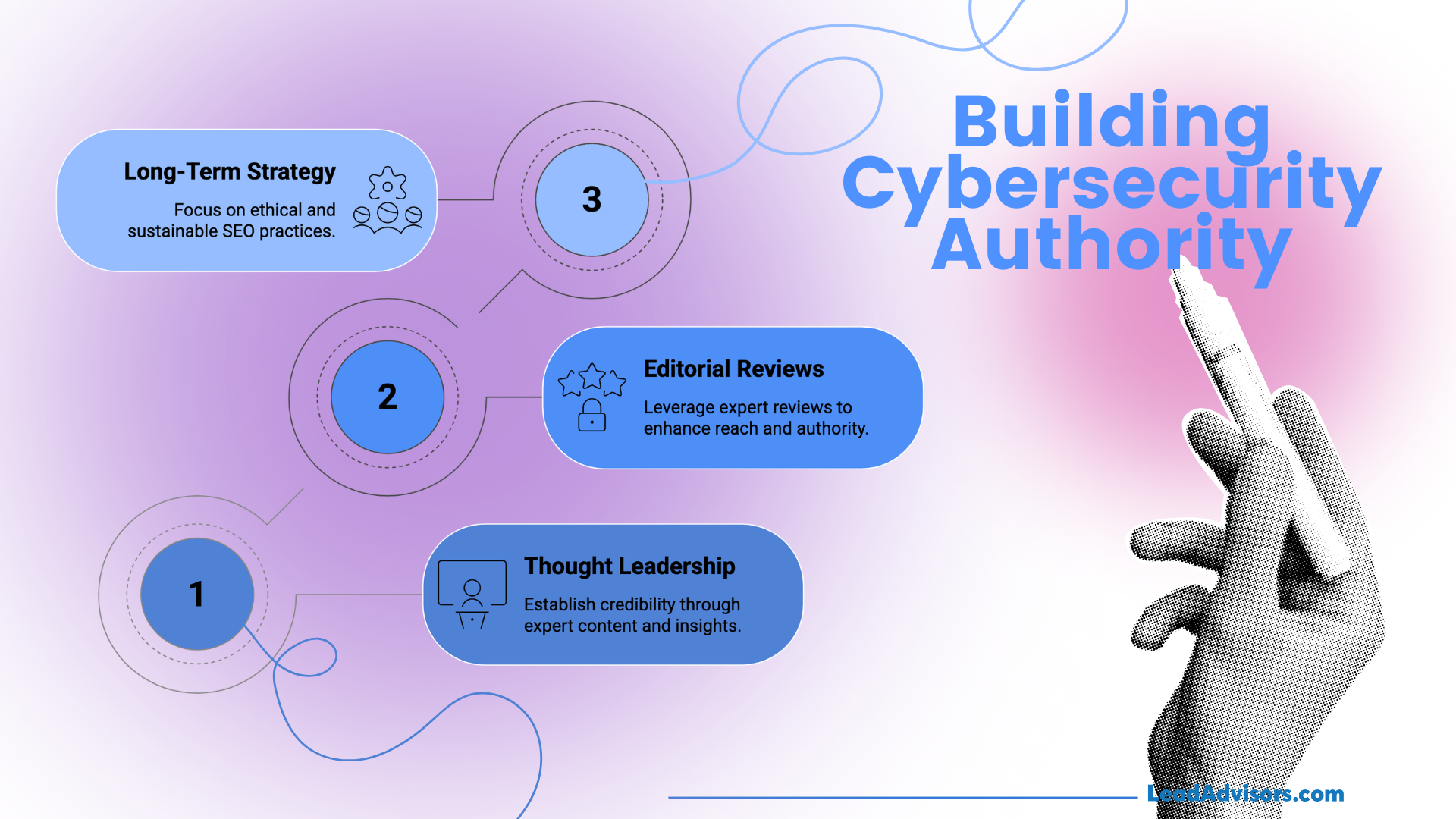
In cybersecurity, authority is everything. You’re not only competing to rank – you’re persuading cautious, security‑minded buyers to trust you. That’s why link-building isn’t about shortcuts; it’s a reputation strategy.
Pillar 1: Build Authority Through Thought Leadership
Credibility begins with content. When cybersecurity experts share insights, provide commentary, or publish articles, they gain visibility and backlinks.
- Contribute guest posts to reputable sites.
- Get quoted in an industry report.
- Collaborate with outlets like Wired, CSO Online, or Infosecurity Magazine.
These links boost SEO and signal to both search engines and buyers that your voice matters.
Pillar 2: Expand Reach With Editorial Reviews
Affiliate editorial reviews are expert-written pieces on high-authority sites designed to rank and persuade. They:
- Showcase your product with keyword-rich content and CTAs
- Provide backlinks from trusted platforms.
- Strengthen branded presence in search results.
Formats include brand reviews, evergreen guides, best-of listicles, and business tech buyer features. Whether launching a product or repairing reputation, editorial reviews improve domain authority, EEAT signals, and organic conversions.
Pillar 3: Play the Long Game
There are no shortcuts. Paid listings, link farms, or doorway pages destroy SEO and erode trust – the one thing cybersecurity firms can’t afford to lose.
Instead, focus on earned links, partnerships, and scalable editorial strategies. Authority in cybersecurity SEO is built on intention, honesty, and quality – the same principles your solutions are built on.
Cybersecurity Press Releases for SEO
Press releases aren’t just for journalists anymore – they’re strategic tools that, when timed and executed well, build trust, boost rankings, and strengthen cybersecurity SEO.
When to Publish
Press releases work best around milestones, such as launching a new threat-detection tool, completing a public audit, or securing a major partnership. These moments establish authority and visibility.
How to Optimize
To maximize SEO impact:
- Craft a clear, keyword-rich headline
- Use SEO-friendly URLs and meta descriptions aligned with search intent.
- Add schema markup for better categorization.
- Optimize images with alt tags and relevant file names.
Structure content using the inverted pyramid: lead with the key message, then layer background, stats, and context for clarity.
Distribution Matters
Publish on your site, then syndicate through industry outlets like CyberNewswire for reach, backlinks, and domain authority growth.
The Long Game
Each press release adds to your content portfolio. Over time, consistent updates on launches, audits, or partnerships build visibility, brand authority, and trust – three essentials in the cybersecurity space.
Measuring SEO Success in Cybersecurity
Success in cybersecurity SEO isn’t about glancing at traffic numbers – it’s about tracking the right metrics, using the right tools, and acting on insights.
Key Metrics to Track
| Metric | What It Tells You | Tools |
| Organic traffic | Growth in search-driven visitors | Google Analytics, Search Console |
| Keyword rankings | Progress on cybersecurity and branded terms | Ahrefs, Semrush, Search Console |
| Bounce rate | If visitors leave too quickly (misaligned content/speed issues) | Google Analytics |
| Time on site | Engagement level with your content | Google Analytics |
| Leads & conversions | Whether traffic becomes inquiries or sales | Google Analytics, ConversionIQ |
| Indexed press releases | If PR content appears in search results | Google Search Console |
| Backlink profile | Quality and number of earned backlinks | Ahrefs, Semrush |
Why It Matters
Consistently tracking these KPIs shows the actual impact of your SEO. In cybersecurity, where authority and trust are paramount, even small gains in rankings, engagement, or backlinks can deliver outsized business results.
Common Pitfalls & Cybersecurity SEO Mistakes
Even well-meaning cybersecurity companies can undermine their SEO without realizing it. If you want long-term visibility and trust, avoid these common errors:
1. Ignoring Website Security
Skipping HTTPS, SSL, malware protection, or backups is a dealbreaker. Search engines penalize unsafe sites with deindexing, blacklisting, and rank loss – ironic for a cybersecurity firm.
2. Writing Only for Technical Audiences
Decision-makers like CEOs and COOs need clear, value-driven content. Overloading your site with jargon alienates non-technical buyers and hurts engagement.
3. Treating SEO as a One-and-Done Project
SEO isn’t static. Keep rankings strong with ongoing keyword updates, backlink audits, and performance reviews in Google Search Console.
4. Neglecting Mobile Experience
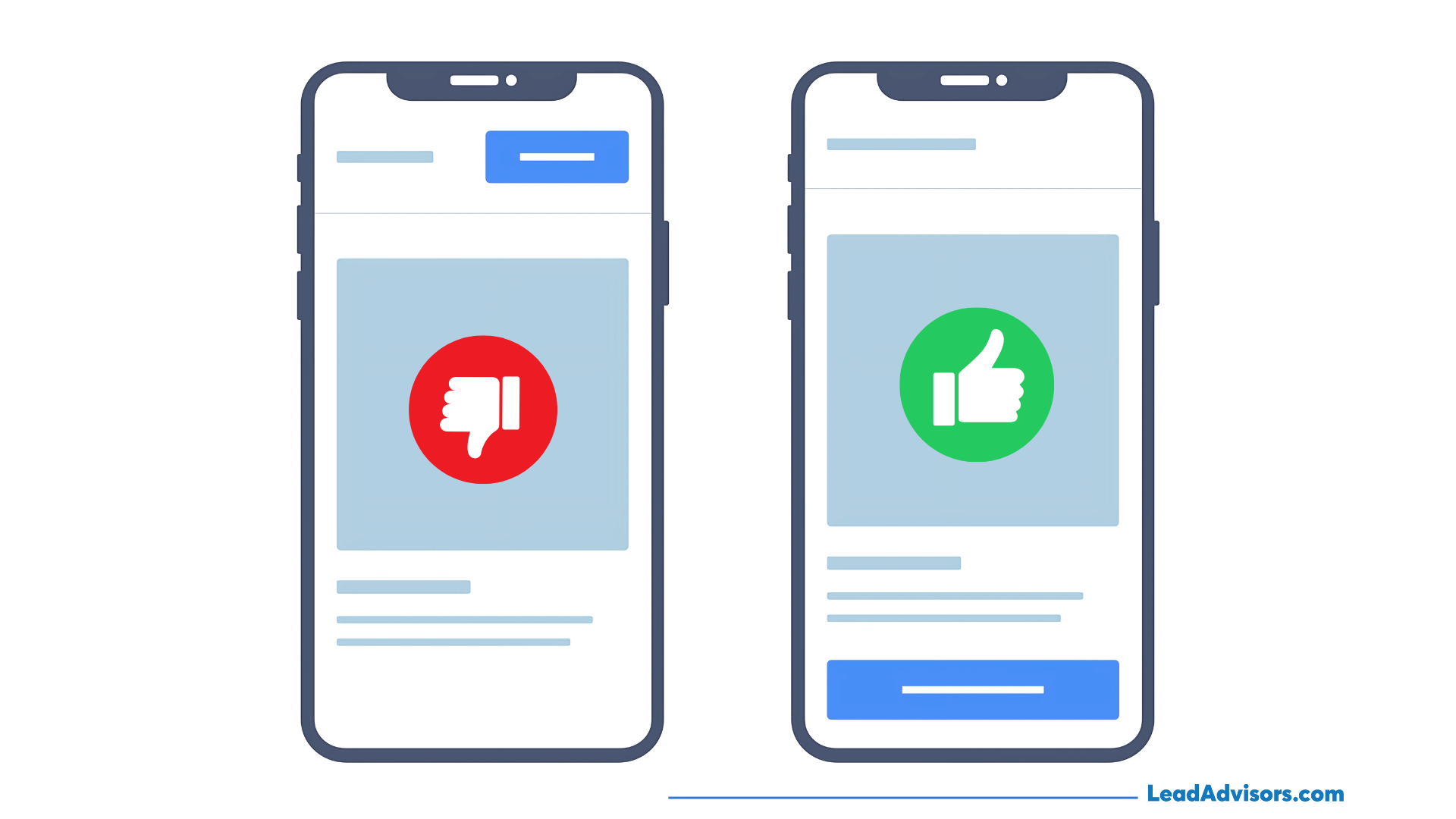
A clunky, slow mobile layout kills both UX and SEO. With mobile-first indexing, poor design directly lowers your visibility.
5. Not Using PR for Social Proof
Well-crafted press releases are essential for new products, partnerships, and threat reports. PR strengthens authority, earns backlinks, and boosts search visibility.
Avoiding these pitfalls not only preserves rankings but also builds trust and a more user-friendly brand.
Future Trends: AI, Zero-Click, and SEO for Cybersecurity
Cybersecurity SEO is evolving fast. Staying ahead means preparing for what’s next, not just optimizing for what works today. Following the key SEO trends in 2025 helps you anticipate changes before they impact your rankings.
AI Overviews & Zero-Click Search
Google’s AI summaries and featured snippets let users find answers without clicking. To win visibility in search engine results pages, your content must be – and you’ll need to understand how to rank in AI overviews with formatting and content tailored for AI-driven search results – by ensuring it is:
- Structured with clear headers and bullet points
- Concise and definition-focused
- Backed by authoritative, accurate sources
EEAT (Expertise, Experience, Authoritativeness, Trustworthiness) is more crucial than ever. For cybersecurity sites, credibility isn’t optional – it’s foundational.
The Rise of Programmatic SEO
Programmatic SEO (pSEO) uses data and templates to scale hundreds of long-tail pages like “best firewall for small businesses” or “endpoint security for remote teams.” Done well, it builds a strong footprint in competitive niches. Done poorly, it risks low-quality content penalties.
AI + SEO + Cybersecurity: A Strategic Trio
AI isn’t just shaping search – it’s transforming how cybersecurity firms create content. With AI, you can:
- Convert live threat intel into blog updates
- Automate news-style posts on active attacks
- Turn alerts into SEO-optimized guides.
The future of cybersecurity SEO is the fusion of AI tools, authoritative content, and agile publishing – reaching users with answers before they even search.
Partner or DIY? When to Hire a Cybersecurity SEO Expert
Not every cybersecurity firm can afford an in-house SEO team – and that’s fine. If you have a capable marketing staff and tools like SEMrush, Surfer, or Screaming Frog, you may handle SEO internally.
However, for most companies, the faster route to higher rankings, authority, and growth is partnering with a specialized agency. Choose one that:
- Knows the cybersecurity industry
- Uses ethical SEO tactics.
- Proves results with tools like Google Analytics and Ahrefs. Some even focus on SEO for resellers, offering white-label services for firms that want expert support without building an in-house department.
- Builds authority through platforms like CyberNewswire
Whether DIY or agency-led, cybersecurity SEO isn’t a quick fix – it’s an ongoing investment in visibility, trust, and growth.
Frequently Asked Questions
How long does it take to see results from cybersecurity SEO?
Can SEO help us recover from a cybersecurity incident or breach?
Should cybersecurity companies invest in paid ads or focus only on SEO?
What’s the difference between SEO for SaaS cybersecurity tools and managed service providers (MSPs)?
How can we create cybersecurity content that’s both technical and accessible?
Final Thoughts: SEO as a Growth Lever for Cybersecurity
Cybersecurity SEO isn’t just about rankings – it’s about reputation. Before clients even speak to you, they judge your trustworthiness through search visibility. Every page signals your commitment to security solutions, performance, and credibility.
SEO is more than a channel; it’s a reputation engine that compounds value when built on expertise, strategy, and ethical practices. Shortcuts fade, but a foundation of visibility and trust drives sustainable growth for cybersecurity companies.





